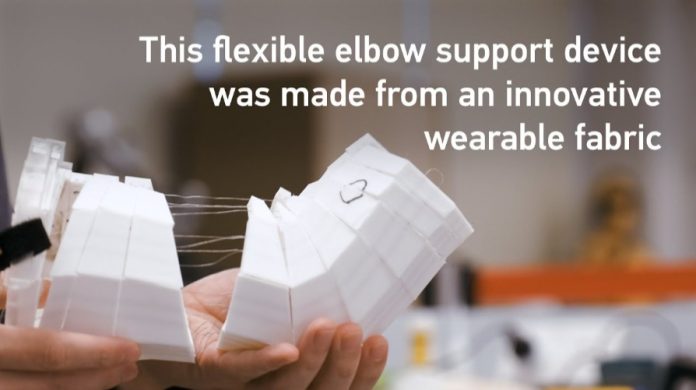
Scientists at Nanyang Technological University, Singapore (NTU Singapore), have developed a groundbreaking wearable fabric called RoboFabric.
This fabric is flexible but can stiffen on demand, making it ideal for medical devices and soft robotics.
RoboFabric was created using geometric design, 3D printing, and robotic control. This innovative technology can be quickly turned into various devices, such as medical supports and robotic limbs for drones.
One of the first applications is an elbow support that helps people carry heavier loads.
The team has also developed a wrist support prototype that could stabilize joints and benefit patients with Parkinson’s Disease who experience trembling.
Inspired by the scales of pangolins and armadillos, which interlock to form a protective shell, the scientists used an advanced mathematical algorithm to design an interlocking system of tiles.
These 3D-printed tiles are connected by metal fibers running through tiny channels between them or by an external soft case that requires a constant vacuum to maintain stiffness.
When the fibers are contracted, the tiles interlock and stiffen, increasing the rigidity of RoboFabric by over 350 times.
This provides additional strength and stability. According to the team’s findings published in Advanced Materials, the device can reduce human muscle activity by up to 40% when assisting joints in lifting loads.
Nanyang Assistant Professor Wang Yifan, the lead scientist from NTU’s School of Mechanical and Aerospace Engineering, explained, “We were inspired by how animals often have multiple functionalities for their limbs through intricate structures, much like the shape-morphing and stiffness-variation in octopuses.”
He envisions that in the future, patients needing a plaster cast for fractures could have the option of customizing a flexible limb support that stiffens when needed. Unlike conventional rigid casts, these would be easy to put on or remove at the touch of a button. Joint supports could also help the elderly with daily tasks by reducing the muscle strength needed for heavier loads.
To customize the joint support, a 3D scan of the wrist or elbow is uploaded to proprietary software. A special algorithm automatically dissects the 3D model into dozens of geometric tiles, which can be 3D printed in just an hour. The metal fibers are then threaded through the holes between the tiles and connected to an electric device that can tighten or loosen the cables. This threading process is currently done by hand but could be automated in the future.
Adjunct Associate Professor Loh Yong Joo from Tan Tock Seng Hospital (TTSH) commented that RoboFabric holds promise for rehabilitation medicine. It could be useful for individuals with joint injuries, post-stroke patients, and those with movement disorders like Parkinson’s disease. If adapted for knee applications, it might improve gait patterns and help prevent falls.
RoboFabric also has potential in robotics. In a research paper published in Science Robotics, the team demonstrated a tiny robot made of wave-shaped tiles sealed in an elastic envelope. When a vacuum is applied, RoboFabric stiffens and takes its designated shape. When the vacuum is removed, it relaxes into a soft state. This allows the robot to climb like a worm or swim in water, carrying small loads or protecting fragile items.
In another demonstration, four RoboFabric robots formed a robotic gripper on a drone. The gripper can pick up small items when rigid and serve as a shock-absorbing pad for hard landings when soft. The grippers can fold into the drone body without affecting its flight.
The team is seeking industry partners for deployment trials in health care and robotics. This made-in-Singapore technology offers new solutions for medical support and enhances the functionality of drones and exploration robots.



